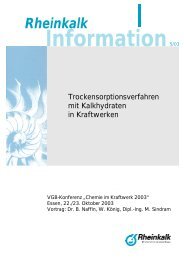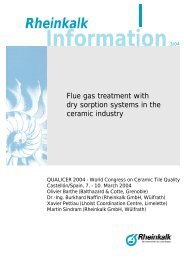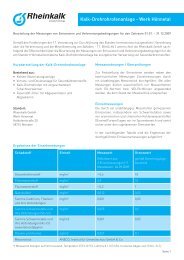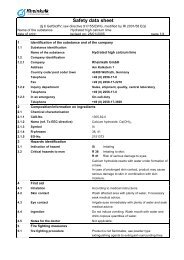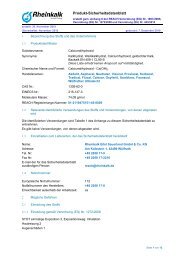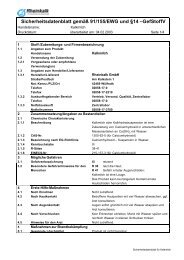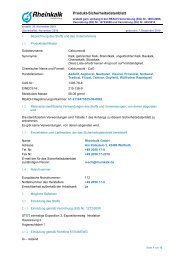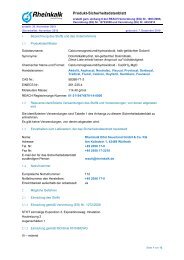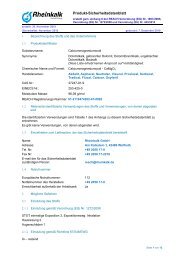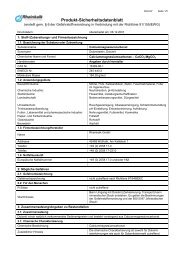Safety data sheet - Rheinkalk
Safety data sheet - Rheinkalk
Safety data sheet - Rheinkalk
Create successful ePaper yourself
Turn your PDF publications into a flip-book with our unique Google optimized e-Paper software.
<strong>Safety</strong> <strong>data</strong> <strong>sheet</strong><br />
(§ 6 GefStoffV; iaw directive 91/155/EWG, modified by Rl 2001/58 EG)<br />
Name of the substance Dolomitic lime<br />
date of print: revised on: 28/01/2005 page 1/4<br />
1 Identification of the substance and of the company<br />
1.1 Substance identification<br />
Name of the substance Dolomitic lime<br />
1.2 Company identification<br />
1.2.1 Company <strong>Rheinkalk</strong> GmbH<br />
Address Am Kalkstein 1<br />
Country code/ post code/ town 42489 Wülfrath, Germany<br />
Telephone +49 (0) 2058-17-0<br />
Fax +49 (0) 2058-17-2210<br />
1.2.2 Inquiry department Sales, shipment, quality, central laboratory<br />
Telephone +49 (0) 2058-17-0<br />
1.2.3 In an emergency On-call-duty<br />
Telephone +49 (0) 2058-17-3600<br />
2 Composition/information on ingredients<br />
2.1 Chemical characterisation<br />
2.1.1 CAS-No. 37247-91-98<br />
2.1.2 Name (ref. To EEC-directive) Calcium magnesium oxide, CaO · MgO.<br />
2.1.3 Symbol Xi<br />
2.1.4 R-phrases 38, 41<br />
2.1.5 EG-No. 2534250<br />
3 Hazards identification<br />
3.1 Indication of hazard Xi Irritating<br />
3.2 Critical hazards to man R 38 Irritating to skin;<br />
R 41 Risk of serious damage to eyes;<br />
Calcium magnesium oxide reacts with water under<br />
formation of a base.<br />
In case of prolonged skin contact, product may cause<br />
serious damage to skin in combination with skin<br />
moisture.<br />
4 First aid<br />
4.1 Inhalation According to medical instructions.<br />
4.2 Skin contact Wash affected area with plenty of water, if necessary<br />
seek medical advice.<br />
4.3 Eye contact Irrigate eyes immediately with plenty of water and seek<br />
medical advice.<br />
4.4 Ingestion Do not induce vomiting. Wash mouth with water and<br />
drink copious quantities of water.<br />
4.5 Notes for the doctor Not applicable.<br />
5 Fire fighting measures<br />
5.1 fire fighting procedure Product is not flammable; use powder type<br />
extinguishing agents to extinguish surrounding fires.<br />
5.2 Remarks Do not bring product into uncontrolled contact with<br />
humid (aqueous) fuels or flammable substances;<br />
danger of self-ignition.
<strong>Safety</strong> <strong>data</strong> <strong>sheet</strong><br />
(§ 6 GefStoffV; iaw directive 91/155/EWG, modified by Rl 2001/58 EG)<br />
Name of the substance Dolomitic lime<br />
date of print: revised on: 28/01/2005 page 2/4<br />
6 Accidental release measures<br />
6.1 Personal precautions Avoid contact with skin and eyes, keep dust levels to a<br />
minimum, ensure that sufficient ventilation or suitable<br />
respiratory protective equipment is used.<br />
6.2 Environmental precautions Avoid uncontrolled spilling of surface waters (pHraising).<br />
6.3 Methods for cleaning up Pick up the product mechanically in a dry way.<br />
7 Handling and storage<br />
7.1 Handling<br />
7.1.1 Precautions for safe handling Keep dust levels to a minimum;<br />
Avoid contact with eyes and skin.<br />
Transport in closed containers or packaging.<br />
7.2 Storage<br />
7.2.1 Conditions for safe storage Store under dry conditions.<br />
8 Exposure controls / personal protection<br />
8.1 Occupational exposure limit:<br />
8.1.1 CAS-No. 37247-91-98<br />
8.1.2 Name of the substance Calcium magnesium oxide<br />
8.2 Limit values of concentration in air<br />
8.2.1 Occupational exposure standard (MAK) 5 mg/m 3 (for calcium oxide)<br />
8.3 Recommended individual protection<br />
8.3.1 Respiratory organs e.g. particle-filtering half mask or particle filter P1-P3,<br />
BGR 190 "rules for the use of respiratory protective<br />
equipment", Main Association of the Industrial<br />
Employers' Liability Insurance Associations (BG).<br />
8.3.2 Hand protection e.g. Nitrile impregnated cotton gloves having CE marks,<br />
BGR 195 "rules for the use of protective gloves", Main<br />
Association of the Industrial Employers' Liability<br />
Insurance Associations (BG).<br />
8.3.3 Eyes protection e.g. goggles with eye-protecting lens; type XZZ 3 or 4,<br />
BGR 192 "rules for the use of eye and face protection",<br />
Main Association of the Industrial Employers' Liability<br />
Insurance Associations (BG).<br />
8.3.4 Body protection Not required.<br />
8.3.5 General safety and hygiene measures Skin protection based on skin protection plan iaw BGR<br />
197 "rules for the application of skin protection", Main<br />
Association of the Industrial Employers' Liability<br />
Insurance Associations (BG).<br />
9 Physical and chemical properties<br />
9.1 Appearance<br />
9.1.1 Consistence Powder, granules.<br />
9.1.2 Colour White to beige.<br />
9.1.3 Smell Odourless.
<strong>Safety</strong> <strong>data</strong> <strong>sheet</strong><br />
(§ 6 GefStoffV; iaw directive 91/155/EWG, modified by Rl 2001/58 EG)<br />
Name of the substance Dolomitic lime<br />
date of print: revised on: 28/01/2005 page 3/4<br />
9.2 <strong>Safety</strong>-related <strong>data</strong> value/range unit<br />
9.2.1 Fusion point Melting point 2570 °C (for calcium oxide)<br />
Boiling point 2850 °C (for calcium oxide).<br />
9.2.2 Flash point Not applicable.<br />
9.2.3 Flammability Not applicable.<br />
9.2.4 Explosion danger Not applicable.<br />
9.2.5 Steam pressure Not applicable.<br />
9.2.6 Specific weight T = 20 °C 3,5 - 3,6 g/cm 3 .<br />
9.2.7 Bulk density T = 20 °C 0,9 – 1,2 g/cm 3 .<br />
9.2.8 Solubility (in water) T = 20 °C 1650 mg/l (as calcium hydroxide).<br />
T = 100 °C 710 mg/l (as calcium hydroxide).<br />
9.2.9 pH (in saturated solution) T = 20 °C 12,6 (as calcium hydroxide).<br />
9.2.10 Partition coefficient Not applicable.<br />
10 Stability and reactivity<br />
10.1 Conditions to avoid Avoid undue exposure to air or moisture.<br />
10.2 Materials to avoid Reacts with acids to form calcium salts, reacts with<br />
aluminium in the presence of moisture to give off<br />
hydrogen. Reacts with water to give a temperature rise.<br />
11 Toxicological information<br />
11.1 Toxicological tests<br />
11.1.1 Acute toxicity In-vivo-studies did not give any indication to this point.<br />
11.1.2 Specific symptoms in animal<br />
experiments<br />
Not applicable.<br />
11.1.3 Irritation/corrosiveness Irritating to skin and mucous membranes.<br />
11.1.4 Additional remarks Not applicable.<br />
11.2 Practical experience<br />
11.2.1 Long term exposure In case of prolonged skin contact, product may cause<br />
serious damage to skin in combination with skin<br />
moisture.<br />
Prolonged and repeated inhalation of dust may damage<br />
the respiratory tract.<br />
12 Ecological information<br />
12.1 Persistence and degradation Not applicable, since inorganic mineral substance.<br />
12.2 Bioaccumulative potential Not applicable, since inorganic mineral substance.<br />
12.3 Additional remarks Avoid uncontrolled spilling of surface waters; adverse<br />
effect by pH-raising (e.g. toxic effect on fish).<br />
13 Disposal considerations<br />
13.1 Product<br />
13.1.1 Comment Further use possible if picked up in a dry way.<br />
13.1.2 Waste identification code according to<br />
ordinance on waste catalogue<br />
101304 (for unused product).
<strong>Safety</strong> <strong>data</strong> <strong>sheet</strong><br />
(§ 6 GefStoffV; iaw directive 91/155/EWG, modified by Rl 2001/58 EG)<br />
Name of the substance Dolomitic lime<br />
date of print: revised on: 28/01/2005 page 4/4<br />
14 Transport Information<br />
14.1 Overland transport ADR/RID and<br />
GGVS/GGVE (cross-border/domestic)<br />
Not subject to identification.<br />
14.2 Inland shipment ADN/ADR Not subject to identification.<br />
14.3 Overseas shipment IMDG/GGVSea Not subject to identification.<br />
14.3.1 UN-Nr. 1910 (for calcium oxide)<br />
14.4 Transport by air ICAO-TI and IATA-DGR<br />
14.4.1 ICAO/IATA- class 8 (for calcium oxide)<br />
14.4.2 PG III (for calcium oxide)<br />
15 Regulatory information<br />
15.1 Labelling according to EEC-Directives<br />
15.1.1 Symbol and classification of the<br />
substance<br />
"Xi" Irritating.<br />
15.1.2 R-Phrases R 38 Irritating to skin.<br />
R 41 Risk of serious damage to eyes.<br />
15.1.3 S-Phrases S 2 Keep out of reach of children.<br />
S 8 Keep container dry.<br />
S 22 Do not breathe dust.<br />
S 24 Avoid contact with skin.<br />
S 25 Avoid contact with eyes.<br />
S 26 In case of contact with eyes, rinse<br />
immediately with plenty of water and seek<br />
medical advice.<br />
S 39 <strong>Safety</strong> goggles/wear face mask.<br />
15.2 National regulations<br />
15.2.1 Restriction to employment Not applicable.<br />
15.2.2 Regulation on accident (StörfallV) Not applicable.<br />
15.2.3 Regulation on accident (VbF) Not applicable.<br />
15.2.4 German technical instruction on air<br />
pollution control (TA Luft)<br />
5.4.2.4<br />
15.2.5 Water endangering class 1 (slightly endangering to water).<br />
15.2.6 Any other rules, restrictions and<br />
prohibiting regulations<br />
Principles of occupational medicine, BG rules of<br />
practice, and others.<br />
16 Other information<br />
16.1 Further information e.g. notes on training, recommended use and<br />
restrictions.<br />
16.2 Department issuing <strong>data</strong> <strong>sheet</strong> Quality assurance, Central laboratory<br />
16.3 Person to contact: Laboratory management




